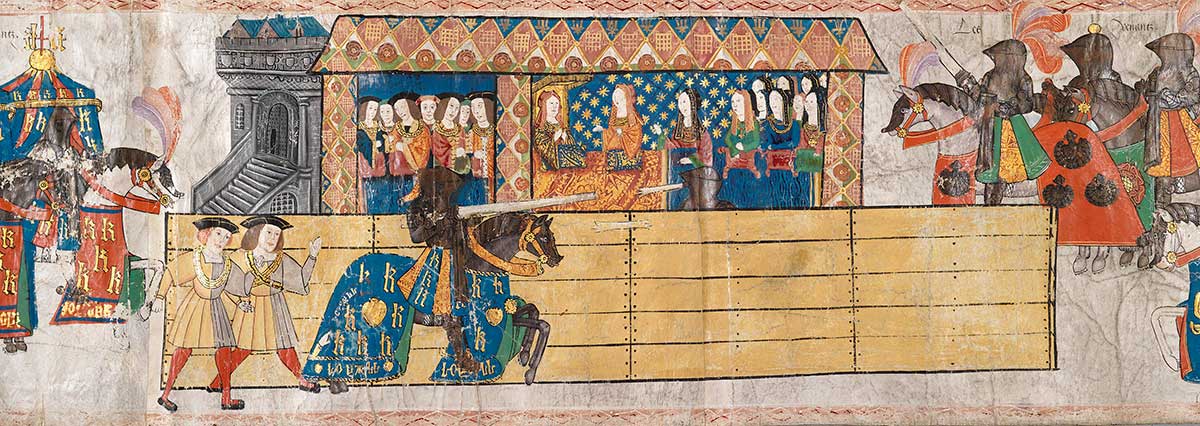Dr Emma Levitt
Historian
King Henry VIII controversially made sure that he was depicted despatching all-comers in battles and tournaments. But historian Dr Emma Levitt finds that the facts tell a different story
WAS King Henry VIII a pioneer of fake news?
A historian at the University of Huddersfield has analysed evidence that the much-married monarch commissioned pictures that depicted him as a mighty warrior who personally sent the French packing on the battlefield, and as a tournament superstar who could outjoust all-comers.
In fact, he kept well away from the front line during an invasion of France and his scorecard in the tiltyard was distinctly feeble.
But the man who was arguably the most controversial monarch in English history was desperate to project an uber-manly image, even after death. He ordered the design of a lavish tomb that would be topped by a life-sized statue of himself on horseback in “an active knightly stance”. It was never built, but would have cost the equivalent of more than £6 million.
Martial masculinity
“Henry was determined to construct a lasting image of chivalrous kingship and martial masculinity, even though his attainments in the military arena were rather slender,” states Dr Emma Levitt, whose researches into medieval masculinity have included detailed examination of surviving scorecards from jousting tournaments of the 1500s and 1600s.
Dr Levitt has presented some of her latest findings at a major international conference of medieval historians. She described the plans for Henry’s tomb, drawn up in 1527, 20 years before he died. He would actually be buried beneath a simple marble slab.
The plans provide evidence for how the king wanted to be remembered, says Dr Levitt, who has also examined two enormous paintings that Henry commissioned towards the end of his life. One of them depicted the aftermath of 1513’s Battle of the Spurs – “arguably more of a skirmish” – when the French fled.
The picture shows Henry on horseback, in the thick of the battle, accepting the surrender of a French knight, despite the fact that he was actually behind the front line.
Dr Levitt has argued that the king was desperate to emulate the feats of his warrior forbear Henry V, the victor of Agincourt a century earlier, but in the absence of victories abroad he used tournaments at home to establish himself at the top of the manly hierarchy.
The College of Arms
 Henry VIII tilting in front of Katherine of Aragon, Westminster Tournament Roll, College of Arms
Henry VIII tilting in front of Katherine of Aragon, Westminster Tournament Roll, College of ArmsIn 1511 a lavish joust was held at Westminster in which Henry VIII led a team of three knights. They were the Challengers, and their opponents the Answerers. The event was vividly depicted in a Great Tournament Roll in the College of Arms
“Arguably the most famous image from this roll is the membrane that shows the king tilting at the barrier against one of the Answerers. Henry is depicted in the foreground running from the left and shattering his spear against his opponent’s helm, in true knightly fashion,” says Dr Levitt
“However, when comparing this representation to the surviving Westminster score cheques also held in the College of Arms, it is evident that the king did not break a single lance on the head of his opponents on either of the two days. Therefore it is apparent that the roll represented an idealised version of the jousting match, rather than reflecting what actually happened.”
Henry’s participation in tournaments, and the designs for his unbuilt tomb are evidence of the martial image that Henry wanted to project. But perhaps the projected cost of the monument made even the king flinch, speculates Dr Levitt.
“It is indeed ironic that a king who lived in such opulence, who hosted such vastly expensive tournaments and pageants, whose court was known in its time as the most splendid in Europe, should lie in a plain vault, marked only by a marble slab.”
- Dr Emma Levitt’s paper titled The whole stature of a goodly man and a large horse: memory, masculinity and the military status of Henry VIII was presented at the International Medieval Congress at the University of Leeds. She has authored a chapter on tournaments for the forthcoming Cultural History of Sport in the Medieval Age 600-1450, edited by Dr Noel Fallows and to be published by Bloomsbury. She presents on Tournaments and turbulence in the reign of Edward IV, the first Yorkist King of England at the 2018 Fifteenth Century Conference taking place at the University of Reading (September 6-8).
Related News
Concentration camp uniform loaned to University
The Holocaust Heritage and Learning Centre welcomes exhibits loaned from the former concentration camps of Buchenwald and Mittelbau-Dora
New book after Documentary Film Symposium success
The new book is entitled Soundings: Documentary Film and the Listening Experience and is co-edited the University’s Dr Geoffrey Cox
